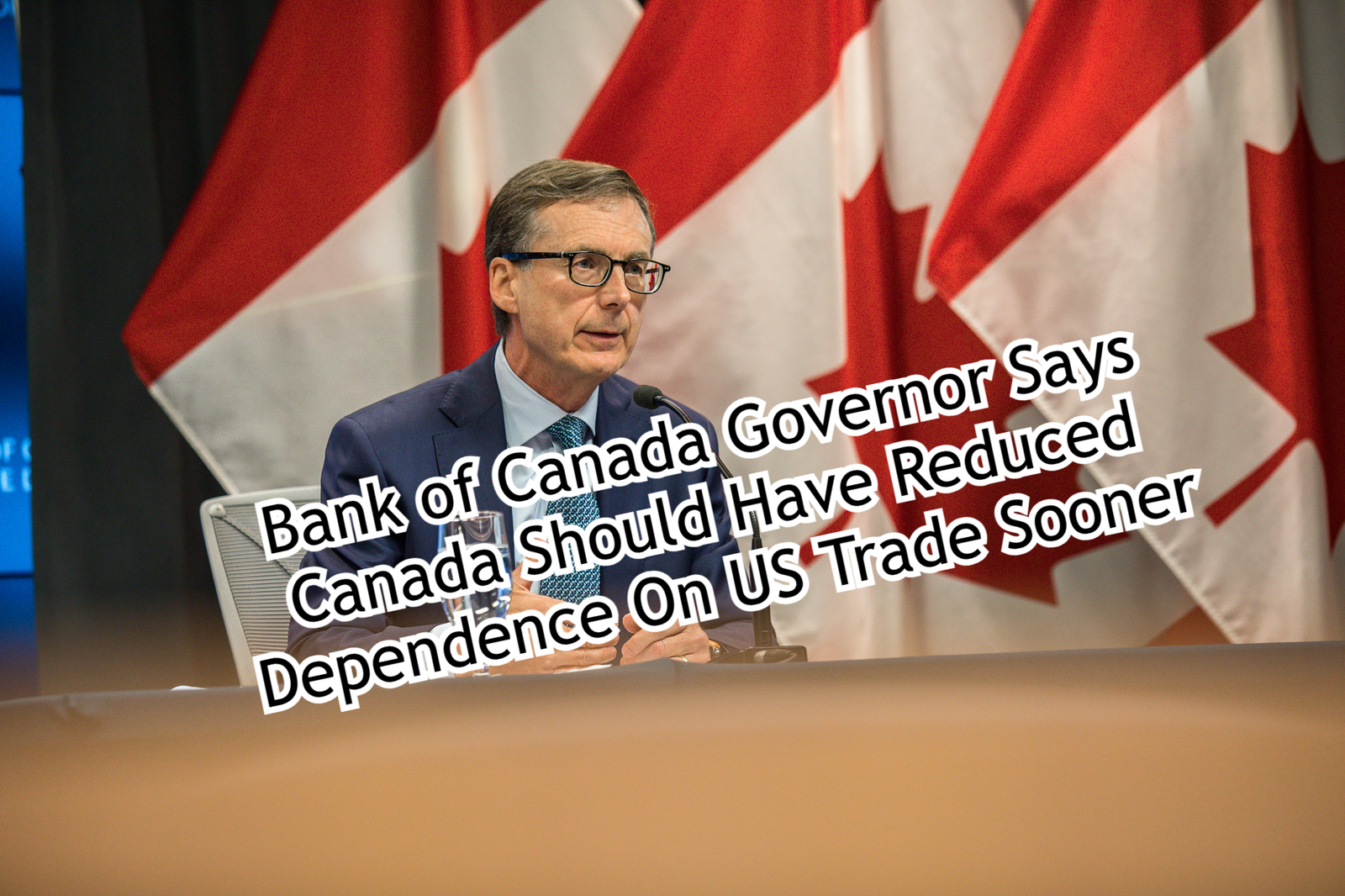Listen to This Article
In a September 23 address to business leaders in Saskatchewan, Bank of Canada Governor Tiff Macklem delivered a candid assessment of Canada’s trade strategy, arguing the country has waited too long to reduce its economic reliance on the United States. He noted that while calls for diversification followed the 2008–09 financial crisis, meaningful progress stalled — and Canada is now facing the consequences.
Global Shifts Demand Urgent Action
Macklem emphasized that rising protectionism, disrupted supply chains, and shifting global trade dynamics make diversification more urgent than ever. Without decisive action, he warned, Canada risks falling behind in its ability to withstand economic shocks and sustain long-term growth.
Tariffs and Export Declines Highlight Vulnerability
Recent U.S. tariffs on steel, aluminum, autos, and softwood lumber have exposed Canada’s trade fragility. Macklem also pointed to China’s restrictions on Canadian canola, which have hit Saskatchewan particularly hard. In Q2 2025, Canadian exports dropped sharply, contributing to a decline in real GDP and early signs of labour market weakness — all underscoring Canada’s deep exposure to U.S. demand.
Even when trade agreements soften the impact of tariffs, Macklem noted, the broader effect of protectionist sentiment has already disrupted trade flows and investor confidence.
Structural Barriers to Diversification
While the U.S. will remain Canada’s primary trading partner, Macklem stressed that expanding trade beyond it requires more than signing new deals. Internal hurdles — including interprovincial trade barriers, inconsistent regulations, infrastructure bottlenecks, and slow approval processes — continue to limit Canada’s ability to capitalize on its agreements with over 50 other countries.
He called for targeted reforms: improving east-west transportation corridors, expanding port capacity, harmonizing provincial rules (especially around professional credentials), and streamlining regulatory approvals.
Canada’s Trade Exposure by the Numbers
- Canada ranks among the most U.S.-dependent economies in the OECD.
- Key exports include energy, vehicles, machinery, metals, and forestry products.
- Trade shocks from tariffs and supply-chain disruptions have repeatedly exposed the risks of overreliance.
- Currency fluctuations and U.S. policy shifts continue to shape Canada’s economic trajectory.
Policy Response and the Road Ahead
The federal government has launched a multi-billion dollar initiative to help Canadian firms enter new markets and mitigate the impact of U.S. tariffs. But Macklem made clear that monetary policy alone won’t fix the structural vulnerabilities. Interest rate cuts may cushion short-term pain, but long-term resilience depends on deeper reforms.
“We should have been making these changes 15 years ago,” Macklem said. “But the next best time is now.”
Side-by-side: export diversification — Canada vs. three peers
| Metric / point | Canada | Australia | Netherlands | South Korea |
|---|---|---|---|---|
| Top export partner (share / reliance signal) | Many Canadian exporters depend almost exclusively on the U.S.: nearly 66% of Canadian exporting firms exported only to the U.S. in 2024 — the highest share since 2003, showing deep U.S. market reliance. | China is Australia’s largest market; in 2023 China bought roughly ~32% of Australia’s exports — Australia is heavily exposed to one partner but that partner is different from Canada’s (China vs U.S.). Top five partners still account for ~62% of exports. | Exports are more regionally spread across EU neighbours: the top five partners (Germany, Belgium, France, the UK, U.S.) account for about 55% of Dutch goods exports — the Netherlands functions as a diversified export and re-export hub. | South Korea’s export mix is spread across major markets: in recent years China and the U.S. have been roughly comparable shares (China ~20% / U.S. ~18% in 2023), with strong shipments to ASEAN/EU as well — showing less single-market domination. |
| Top 3 partners (quick snapshot) | U.S. dominant; second/third vary by sector but far behind the U.S. overall. | China, Japan, South Korea (top 3 by value in 2023). | Germany, Belgium, France (EU neighbors dominate). | China, United States, Vietnam (top partners in 2024). |
| Why diversification is stronger / structural reason | Geographic proximity and integrated supply chains with the U.S., plus regulatory and interprovincial frictions that make intra-Canadian reorientation harder. (Explains “natural” U.S. dependence.) | Heavy trade with Asia (especially China) tied to resource and agricultural exports; proximity to fast-growing Asian markets plus targeted trade diplomacy. | Strategic logistics role (Rotterdam, large ports), re-exporting, EU single market access — a trade hub rather than single-market dependence. Strong transport/port infrastructure enables diversification. | Industrial policy and export orientation in high-value goods (electronics, autos, shipbuilding). Diversified buyers for tech and durable goods reduce single-market risk. |
| Policy levers / enablers used | (Needed) Improve interprovincial trade, invest in ports/rail, targeted export supports, trade missions and regulatory harmonization. (These are recommended, not always fully realized.) | Active trade diplomacy with Asia, export facilitation for resources/agri, investment in port/rail links to Asia. | Investment in ports and logistics; policies that support value-added trade (processing and re-export); EU single-market access is a major structural advantage. | Longstanding industrial promotion (R&D support, export credit, supply-chain development) and diversification within high-tech sectors (chips, autos) that sell to many regions. |
| Practical lesson for Canada | Canada’s closest analogy to “fixing” reliance is structural: remove domestic frictions (interprovincial trade barriers), upgrade transport & port links (Atlantic/Pacific), and pair export promotion with product diversification (move upvalue in energy/agrifood/manufacturing). Use targeted market diversification programs like export credits and trade missions. | Canada could emulate Australia on targeted outreach to Asia (though Australia’s exposure to a single partner brings its own risks). Invest in market access and bilateral ties with fast-growing Asian economies. | Build logistics and re-export capabilities where sensible (improve ports, reduce bottlenecks) and exploit regional trade blocs or supply-chain niches to avoid overreliance on a single market. | Foster higher value manufacturing and tech exports through R&D, supplier networks, and export finance so Canadian firms can sell across a broader range of markets rather than being concentrated on commodity exports to one neighbour. |
Six Concrete Steps Canada Can Take to Reduce Dependance On US Trade
1. Reduce interprovincial trade barriers (High impact / Moderate difficulty)
-
Action: Accelerate implementation of the Canadian Free Trade Agreement (CFTA) by harmonizing rules across provinces (e.g., trucking standards, professional certifications, alcohol distribution).
-
Why: A “bigger home market” strengthens firms and prepares them for global expansion. StatCan estimates interprovincial barriers cost the economy billions annually.
-
Timeline: Several reforms can be negotiated and legislated within 2–3 years.
2. Expand port and transport capacity on both coasts (High impact / High difficulty)
-
Action: Fast-track approvals and investments for Vancouver, Prince Rupert, Halifax, and St. John’s port expansions, plus east–west rail/road infrastructure.
-
Why: Physical bottlenecks limit export diversification, particularly for agriculture, energy, and manufactured goods headed to Asia and Europe.
-
Timeline: Major projects take longer, but permitting and funding decisions can be made within 12–18 months to unlock private and provincial investment.
3. Targeted export finance and insurance programs (Medium-high impact / Low difficulty)
-
Action: Scale up Export Development Canada (EDC) programs that provide financing, insurance, and guarantees for SMEs entering new overseas markets.
-
Why: Firms are often risk-averse when breaking into unfamiliar markets. Government risk-sharing accelerates diversification.
-
Timeline: Can be expanded through budget measures within 12 months.
4. Strategic trade missions & market access deals in Asia and Europe (Medium impact / Moderate difficulty)
-
Action: Focus on India, ASEAN (Vietnam, Indonesia, Philippines), Japan, and African growth markets with targeted trade delegations, regulatory cooperation agreements, and sector-specific memoranda of understanding.
-
Why: Canada has FTAs with 50+ countries, but utilization is low. Active political and commercial outreach boosts usage.
-
Timeline: Missions and agreements can be launched within 12–24 months.
5. Support sectoral diversification into high-value exports (Medium impact / Moderate difficulty)
-
Action: Provide R&D tax credits, grants, and scaling programs for cleantech, agrifood processing, advanced manufacturing, and digital services.
-
Why: Canada’s current export base is dominated by energy and raw resources. Higher-value exports are easier to sell to multiple markets.
-
Timeline: Expanded incentives could be rolled out in the next federal budget, with results in 2–3 years.
6. Streamline regulatory approvals for major export projects (Medium impact / High difficulty)
-
Action: Shorten timelines for resource and infrastructure approvals while maintaining environmental safeguards, using “one project, one review” models.
-
Why: Global buyers need reliable supply. Long approval processes weaken Canada’s competitiveness.
-
Timeline: Legislative/regulatory changes could be introduced within 24–36 months.










